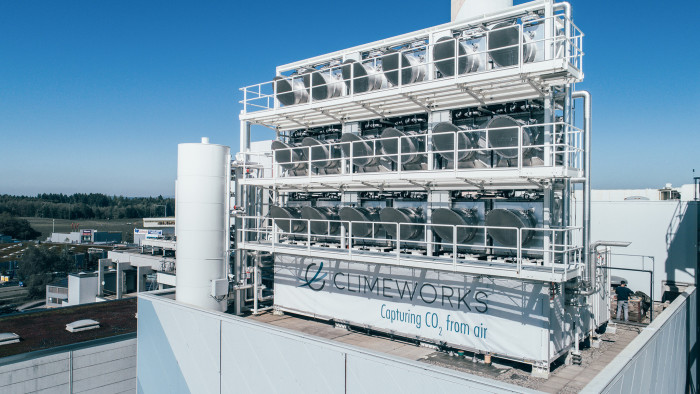Scientists attempt to breathe new life into CCS

Roula Khalaf, Editor of the FT, selects her favourite stories in this weekly newsletter.
“Carbon capture and storage is the only hope for mankind,” Sir David King, former chief scientist to the UK government, declared in 2015.
His remark was prompted by the stark fact that if the targets set by the Intergovernmental Panel on Climate Change for increases in global temperature are to be met, the world will have to cut net carbon dioxide emissions by between 50 and 80 per cent by 2050.
Taking a realistic view, even drastic curbs on burning fossil fuels and adoption of renewable and nuclear energy will not be sufficient by themselves to reduce emissions to that extent. In addition, carbon capture and storage (CCS) will have to be deployed on a large scale to remove CO2 from the waste products of power generation and industrial processes — or directly from the air — and lock it away so that it cannot enter the atmosphere.
CCS technology has been under development since the 1990s, with more than 20 plants operating or under construction around the world, and at least 100 smaller-scale research projects under way. But CCS “remains a pre-commercial technology”, says Claire Perry, UK minister for energy and clean growth.
But while there is widespread agreement among energy and environment experts that a new stimulus is needed to accelerate CCS to the commercial stage after a period in which the technology has lost momentum, there is less agreement about how this can be achieved.
A report published in July 2018 by the UK government’s Carbon Capture Usage and Storage (CCUS) task force recommended the development of at least two CCS clusters — regional groupings of facilities sharing infrastructure and knowledge — to begin operations in the mid-2020s. The government’s longer-term ambition is to “have the option to deploy CCUS at scale during the 2030s, subject to costs coming down sufficiently”.
CCS is mentioned increasingly as a technology not only to capture CO2 from power stations and industrial plants burning fossil fuels — which can remove up to 90 per cent of emissions but still results in a net addition of carbon to the atmosphere — but also to facilitate what has become known as greenhouse gas removal (GGR).
The aim of GGR is permanent removal of carbon dioxide already in the atmosphere. This can be done partly through simple low-tech methods, such as planting trees and restoring habitats such as wetlands, so that they absorb more CO2. But to make the required impact, GGR will have to employ CCS on a substantial scale.
This month, the UK’s Royal Society and Royal Academy of Engineering issued a joint report on GGR. This showed how Britain could have a carbon-neutral economy during the second half of this century if strong curbs on fossil fuels were accompanied by widespread deployment of CCS.
The authors estimate that, through stringent decarbonising of the economy, the UK could cut new emissions of CO2 from 468m tonnes in 2016 to 130m tonnes in 2050. This would have to be removed by GGR to achieve zero net emissions. More than half the required reduction would depend on effective use of CCS. The rest would come from replanting and habitat restoration.
Some CO2 will be removed directly from the air through vast plants, sometimes called artificial trees, which capture carbon in a reversible chemical reaction. Small prototype CO2 removal plants are running in Switzerland and Canada but huge technical improvements will be required to make the technology commercially viable.
The report says the largest quantity of CO2 will have to be extracted from the emissions of power stations burning biomass, such as trees that have already absorbed atmospheric carbon. This technology is to be demonstrated in a pilot at Drax power station, North Yorkshire, which burns wood pellets.
Gideon Henderson, professor of earth sciences at the University of Oxford, says much uncertainty still surrounds the best CCS technology for extracting CO2, whether from power stations or more diffusely from the air, and the best places to store it.
Some advocate pumping CO2 deep underground, into depleted oil and gas reservoirs for example, although there may be a long-term risk of leakage. A more secure solution would be to immobilise the CO2 through chemical reactions that incorporate it into carbonate rocks, though a problem here is the huge volume of rock that would need to be created.

Comments